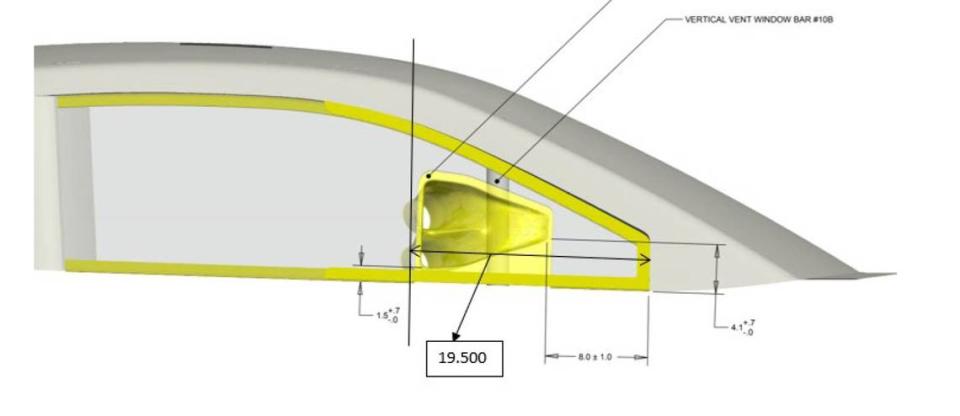NASCAR removes right-side window to keep drivers from cooking in their cars
NASCAR driver Chris Buescher said two of the three hottest races he’d ever competed in during his 15-year career happened in 2020 — one at Martinsville in June and the other at the Daytona road course last Sunday.
The third was an ARCA event in New Jersey years ago in which Buescher said the temperature hit triple digits and the air hose in his car fell off, creating an almost unbearable hotbox effect. The No. 17 driver said he had to spend 30 minutes sitting in his car pouring water on himself after that ARCA race just to “come back to” and that he probably should have taken himself out mid-competition to visit the infield care center.
Buescher said he didn’t reach that level of heat exhaustion last Sunday, but called a 130-degree estimate of the temperature inside his car at Daytona “generous.” He said it was probably closer to 140 or 150 degrees.
“I know it was a situation where if that race would’ve been a whole lot longer, it very well could have been something you had to start worrying about fluids and trying to cool off at the end,” Buescher said.
Some Cup and Truck Series drivers and team members didn’t make it to the end. At least two crew members of Daniel Suárez’s No. 96 team visited the infield care center mid-race and No. 27 driver J.J. Yeley exited the race early after his air conditioner unit broke. The outdoor temperature hovered in the low-90s during the race, which is not necessarily the hottest conditions some of these drivers have experienced, but the combination of heat, humidity and a brand new road course Sunday was punishing.
“I think we’re getting to a point where we’re not just talking about fitness level,” No. 34 driver Michael McDowell said. “We’re talking about, like, dangerous. I think there’s a chance that guys could have serious issues from getting this hot.”
NASCAR said it’s working to address the heat in the cars. One of the issues the sport has identified is the addition of a right front passenger’s side window. Prior to 2019, the right front windows did not have to be sealed for road courses or tracks under 1.5 miles, meaning short tracks and a few intermediates, but NASCAR noticed teams were manipulating the area for an aerodynamic advantage, so the sanctioning body stepped in and required the right-side window through last season and this year.
“The thing that has changed has been a right-side window,” Buescher said. “So there’s pretty clear indication to me of what’s creating this heat that so many drivers are starting to be a little bit more vocal about.”
NASCAR Cup Series managing director Jay Fabian said that the addition of the mandatory window combined with a new aero package, which includes changes to the front radiator pan and front splitter, had ultimately decreased airflow into the car and created a hotter cockpit. On Tuesday night, NASCAR sent a memo to teams saying that they would be allowed to remove most of the front window for the upcoming races at Dover, a one-mile intermediate track, which Fabian said should help create more airflow.

“The cars are sealed up pretty well so we can force air in there, but if it doesn’t evacuate then it’s hot air that doesn’t circulate throughout the car,” Fabian said. “So we’re hoping with the side window open, it can create more of an airflow in and out of the car to get the drivers a little bit more cool.”
The problem, though, is that the air circulating through the car is still going to be the same temperature as the air outside, which will still be hot for certain tracks. This weekend at Dover will provide somewhat of an imperfect test since it will be in the mid- to high-80s, according to the National Weather Service, significantly cooler than last weekend’s race at Daytona.
The real tests for the window update should come at Darlington (an intermediate track less than 1.5 miles) and Richmond (a three-quarter mile short track) beginning in a few weeks. NASCAR said it will use Dover as a trial and update from there if needed.
“At this point, it’s still speculation of whether it will actually make things cooler in there,” Fabian said, noting that Truck Series drivers were equally hot at Daytona (they didn’t run the same side windows like the Cup cars).
Other in-car air-cooling devices teams have at their disposal are NACA ducts, an aeronautic crevice on the car body used to create airflow while minimizing drag, thin hoses directed at the driver, and an in cockpit air-conditioning unit, but Fabian said that the devices that aren’t mandatory probably aren’t getting maximized by teams to give them a speed advantage.
“Teams and drivers are their own worst enemies because we’re trying to get every aero advantage we can and all those things,” McDowell said. “And it’s a shame that we’re like that but that’s just the competitive nature of it. We need NASCAR to protect ourselves from ourselves if that makes sense.”
McDowell and other drivers are optimistic about the window reduction, but only time will tell how much they really cool down.
“That’ll help a tremendous amount,” McDowell said. “And, hopefully, teams will get on board with not cheating the system so we don’t get stuck cooking in these cars.”

